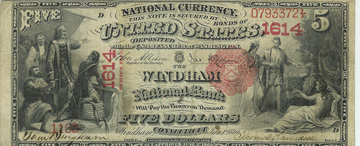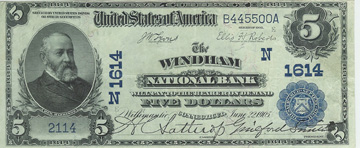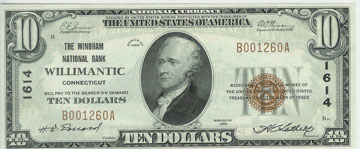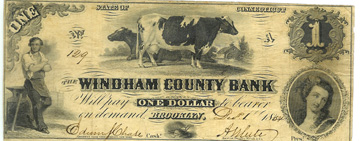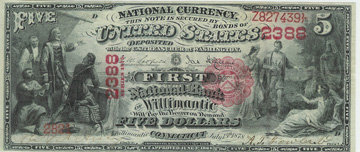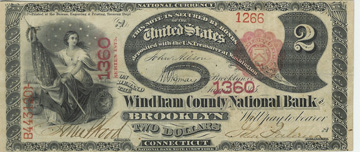Old Banknotes Reflect Region's History
On or about Oct. 11, 1777, Mansfield Justice of the Peace Constant Southworth signed his name to several pieces of paper money which would become, therefore, worth either four or five pence. Since these were small, somewhat crudely printed pieces of currency, they might have been lost or kept hidden away in some attic, but for collectors who specialize in paper money.
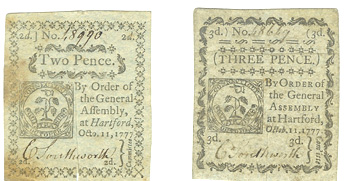
Mansfield resident C. J. , for instance, has in his collection of paper money examples of two-pence and a three-pence note signed by Southworth, who was involved in the state politics of his very important day. It was considered a great honor to sign money for one’s town in the days of the Revolutionary War.
C. J. says the money issued by towns and states quickly depreciated in value, just as did the notes authorized by the Continental Congress which became the subject of the saying: “It’s not worth a continental.”
Much later, during the 1800’s, private banks issued paper money under charter to the state. In Windham Center in 1860, for instance, the Windham Bank issued $2 bills upon which are featured the town’s legend of the “Battle of the Frogs,” by having engraved in the right hand corner a figure of a live frog squatting over a dead one.
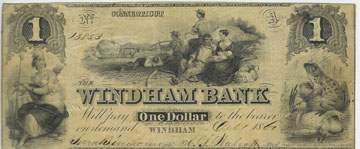
The full story of the beginnings of the legend can be found by clicking here for the entire essay on “The ‘Frog’ Notes of Windham, Conn.” and centers on activities of the Windham Bank which, chartered in 1832, began issuing bank notes which are now “extremely rare.” The later bank notes issued by the bank in denominations of one, two, three, five and ten dollars contain the frog vignette “reminding everyone that touched them of the famous battle of the frogs.”
This is an example of a $5 note of 1866 of the Windham National Bank.
In 1879, the Windham Bank moved to Willimantic and became known as the Windham National Bank. With the coming of national currency, it issued notes charter-numbered 1614 and could no longer put frogs on its currency.
This is an example of a large size $5 note
of 1905 of the Windham National Bank.
A small size $10 note of 1929 of the Windham National Bank.
In 1955, the Windham National Bank merged with the Connecticut Bank and Trust Co. The Connecticut Bank and Trust was bought by Fleet Bank of Boston, Massachusetts, which in turn was bought by Bank of America which still has an office in Willimantic.
As C. J. says, “Collecting old bank notes brings the collector close to the history of his town and the towns of his area.”
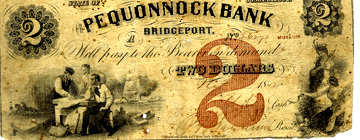
Among the bank notes of C. J.’s collection, for instance, is a $2, 1852 note of the Pequonnock Bank of Bridgeport signed by P.T. Barnum. “He was a banker before he entered the entertainment field,” says C. J.
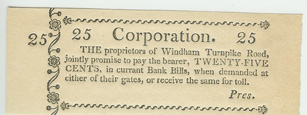
In addition, C. J. has a note once issued by the Proprietors of the Windham Turnpike Road, which ran from Coventry, through Windham to Plainfield;
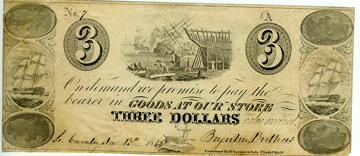
a $3 bill issued by the Boynton Brothers, store owners, of Coventry and dated Nov. 13, 1845, and
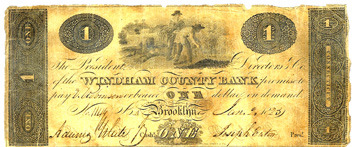
a $1 bank note issued by the Windham County Bank of Brooklyn, Connecticut in 1823 and signed by Joseph Eaton, descendants of whom still live in the area.
This note of the Windham County Bank dated 1854 shows the advances
in engraving technology that took place during the thirty-one years
following the earlier issue.
This is a $5 note of 1878 of the First National Bank of Willimantic.
The bank was short lived, only about 17 years in existence. It was
chartered on June 20, 1878 and went into receivership on April 23,
1895. Examples of bank notes of this bank are extremely rare,
only 4 are known in collections.
This is an example of a Windham County National Bank
of Brooklyn, Connecticut $2 bill. Collectors commonly refer
to this style and denomination as a "Lazy Deuce".
|











